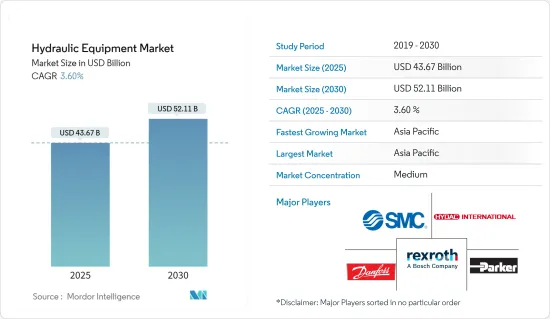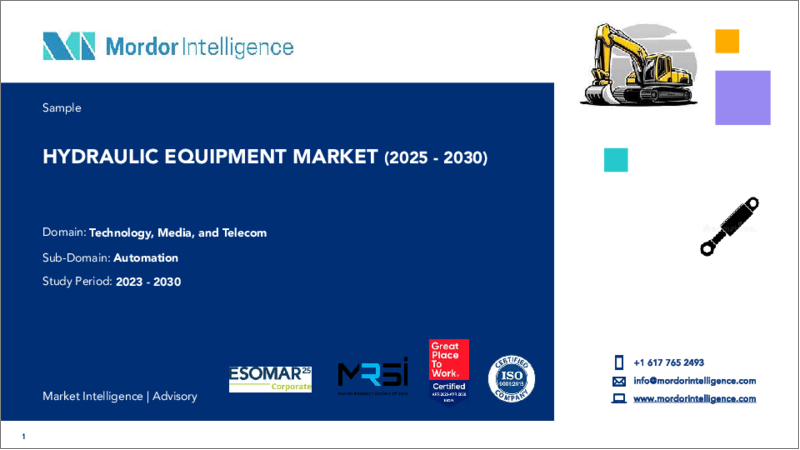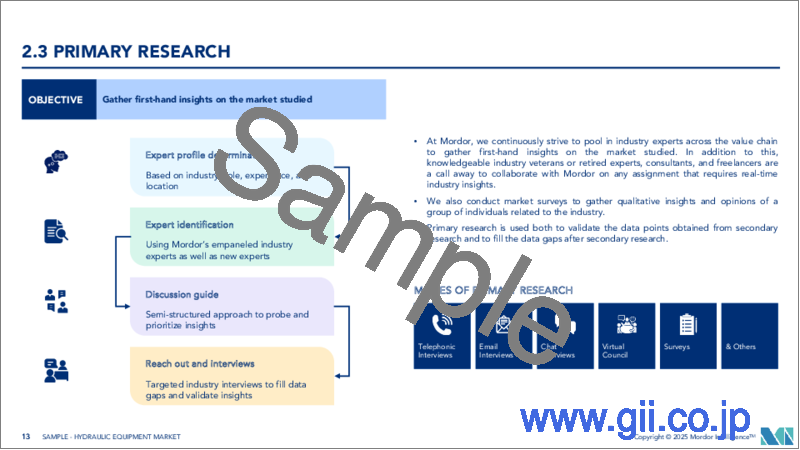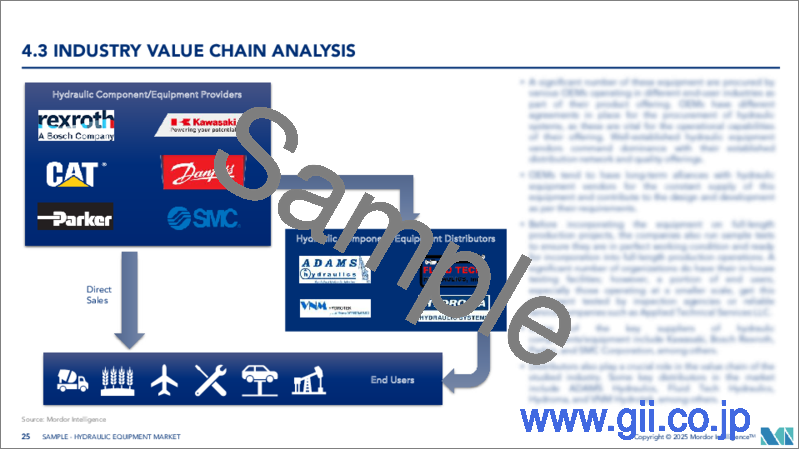|
|
市場調査レポート
商品コード
1689771
油圧機器:市場シェア分析、産業動向・統計、成長予測(2025年~2030年)Hydraulic Equipment - Market Share Analysis, Industry Trends & Statistics, Growth Forecasts (2025 - 2030) |
||||||
カスタマイズ可能
適宜更新あり
|
|||||||
| 油圧機器:市場シェア分析、産業動向・統計、成長予測(2025年~2030年) |
|
出版日: 2025年03月18日
発行: Mordor Intelligence
ページ情報: 英文 162 Pages
納期: 2~3営業日
|
全表示
- 概要
- 目次
油圧機器の市場規模は2025年に436億7,000万米ドルと推計され、予測期間(2025-2030年)のCAGRは3.6%で、2030年には521億1,000万米ドルに達すると予測されます。

プロセス産業の拡大、マテリアルハンドリング機器の需要増加、建設セクターの急成長が油圧機器市場の主な促進要因です。さらに、技術の進歩は油圧機器の開発に拍車をかけているだけでなく、インテリジェント油圧ソリューションの需要も増幅させています。例えば、IoTは主に電気システムに関連してきたが、現在では流体動力システムにも大きく進出しています。最新の油圧機器では、機動性を高めるための電子機器や、包括的なデータ収集のためのセンサーの統合が進んでいます。
主なハイライト
- 新たな動向に対応し、油圧機器は大きく進化しています。業界の方向性を決定づけたのは、エンドユーザーの需要動向です。
- 技術革新と業界のさまざまな需要に後押しされ、市場は絶え間なく進化しています。スマートシステムの統合や軽量材料の使用といった動向は、油圧工学の領域を再構築しています。産業界が効率性、持続可能性、カスタマイズ性を重視する中、油圧機器は、世界の進歩を推進する機械やシステムに活力を与える上で極めて重要な役割を果たす態勢を整えています。
- 自動車、金属、建設、鉱業などのセクターが自動化をますます採用し、eコマースが台頭するにつれ、マテリアルハンドリング機器市場は成長に向かっています。油圧機器は、機器の機能、制御性、パワー、安全性を高める上でますます重要になってきています。その結果、マテリアルハンドリング機器に対する需要の高まりが油圧機器市場を後押ししています。
- 最適な性能を確保するためには、油圧システムの定期的なメンテナンスが不可欠です。これには、作動油レベルのチェック、シールの交換、ホースやバルブの点検などが含まれます。しかし、このような日常的な作業は事業の運営コストにつながります。メンテナンス費用の増大は、特にメンテナンスの必要性が少ない代替品が利用可能な場合に、油圧機器への投資を躊躇させる可能性があります。さらに、ステンレス鋼、鉄鉱石、アルミニウム、青銅などの原材料価格の変動は、油圧機器の価格に変動をもたらしています。
- さらに、モーター、バルブ、油圧シリンダーのような重要な部品には、多額の初期投資が必要です。このような初期費用は、機器の全体的な所有費用に影響し、最終的に工場の利益率を引き締めています。
油圧機器市場の動向
マテリアルハンドリング分野が大きな成長を遂げる
- 流体移送ソリューションは、マテリアルハンドリングでますます採用されるようになっています。このプロセスでは、製品、バルク材料、部品の移動、持ち上げ、位置決めが行われ、主に流通と完成品の保護が行われます。この広大な市場は、さまざまな産業の効率的な運営にとって極めて重要であり、製品のライフサイクル全体を通じて、慎重かつ正確に取り扱われることを保証しています。
- 油圧機器は、サプライチェーン全体のマテリアルハンドリングの中心的存在です。製品の移動、保管、制御を容易にし、複雑な動作シーケンスを可能にします。これは特に配送センターや倉庫において顕著であり、油圧プロセスの精度と信頼性は商品の流れを維持し、ダウンタイムを最小限に抑えるために不可欠です。
- 油圧を活用することで、物流センターはより安全で効率的な作業環境を作り出すことができます。油圧は重量物を持ち上げる機械に力を与え、従業員の人間工学を向上させ、コンベヤシステムで迅速なペース環境をサポートします。例えば、梱包用の材料を素早く搬送するベルトコンベアは、時間を節約するだけでなく、作業員の身体的負担を軽減し、より健康的で生産性の高い労働力をもたらします。
- eコマースの急成長と物流の進歩に後押しされ、この分野は需要が急増しています。最大のeコマース市場である米国では、マテリアルハンドリングソリューションに対する需要が高まっています。2024年5月に米国国勢調査局が発表した報告書では、この動向が強調されており、2024年第2四半期の米国の小売eコマース売上高は2,916億4,000万米ドルに達し、前年同期の2,728億2,000万米ドルから増加したことが指摘されています。eコマースの倉庫や配送センターでは、油圧を顕著に利用するフォークリフトのようなマテリアルハンドリングソリューションの採用が増加しており、こうした動向は大きな市場機会を裏付けています。
大きな成長を記録するアジア太平洋地域
- アジア太平洋地域では、マテリアルハンドリング機器に対する需要の高まり、インフラ開発への投資の増加、および全体的な機器コストの削減傾向が市場の成長を促進しています。制御のしやすさ、コンパクトさ、軽量性、信頼性で支持されている油圧ソリューションは、従来の方法を凌いで人気が急上昇しています。今日、建設、屋根工事、マテリアルハンドリング、石工、自動車、航空、製造などの分野では、最新の油圧機器が活用されています。
- 海外からの投資は、東南アジア全域のインフラや建設プロジェクトにますます目を向けており、市場の見通しを強めています。2024年3月、オーストラリア政府は東南アジアのインフラ整備に13億3,000万米ドルを投資する計画を発表しました。同時に、中国の東アジア諸国に対する資金拠出額は500億米ドルを超え、大きな節目を迎えました。
- 2024年3月、ドイツはフィリピンのインフラ、特に製造業と工場の自動化を強化する目的で、フィリピンに40億米ドルを投資しました。一方、マレーシアは東南アジアにおける重要な投資ハブとして台頭しつつあります。こうした資本の流入は、マテリアルハンドリング機器の需要を増幅し、市場の成長を促進する態勢を整えています。
- さらに、最近のイニシアティブは、先進電気自動車(EV)技術製造のフロントランナーとしての地位を確立しようというインドの野心を強調しています。この動きは、2030年までに新車の30%を電動化するというインドの目標に合致しており、急成長するインド市場での足場を固めるために世界企業を誘致することを目的としています。このような軌跡を踏まえると、インドの自動車市場は力強い成長を遂げ、研究領域でのさらなる機会が生まれると予測されています。
油圧機器産業の概要
油圧機器市場は半固体化しています。Bosch Rexroth AG(Robert Bosch GmbHの一部)、Parker Hannifin Corporation、HYDAC International GmbH、Danfoss A/S、SMC Corporationといった老舗ベンダーは、長期にわたってこの業界に参入しています。その長年の経験により、市場力学や新たなニーズに対する深い洞察力を得ています。その結果、これらの企業は一貫して革新的な製品に投資を行い、社内の生産プロセスを強化し、提供する製品の価値を高めています。
Bosch Rexroth AG、Parker Hannifin Corporation、Hydac International GmbH、Danfoss A/Sのような企業は、その広範な地理的範囲と強力なブランド認知により、市場での圧倒的な存在感を維持する態勢を整えています。
品質認証、サービス内容、価格設定、技術的専門知識といった主要な要素は、新規契約を獲得する上で極めて重要です。さらに、デジタル化動向が勢いを増すにつれて、スマート油圧機器に対する需要が高まり、新規参入企業にとって有利な市場機会をもたらしています。
その他の特典:
- エクセル形式の市場予測(ME)シート
- 3ヶ月間のアナリストサポート
目次
第1章 イントロダクション
- 調査の前提条件と市場定義
- 調査範囲
第2章 調査手法
第3章 エグゼクティブサマリー
第4章 市場洞察
- 市場概要
- 技術動向
- 産業バリューチェーン分析
- マクロ経済要因が市場に与える影響
- 業界の魅力度-ポーターのファイブフォース分析
- 供給企業の交渉力
- 買い手の交渉力
- 新規参入業者の脅威
- 代替品の脅威
- 競争企業間の敵対関係
第5章 市場力学
- 市場促進要因
- マテリアルハンドリング機器に対する需要の増加
- 政府のイニシアティブと投資による建設業界からの需要増加
- 市場の課題/抑制要因
- 機器の寿命に渡る高いメンテナンスコスト
第6章 市場セグメンテーション
- タイプ別
- ポンプ
- バルブ
- シリンダー
- モーター
- フィルターとアキュムレーター
- トランスミッション
- その他の製品タイプ
- エンドユーザー産業別
- 建設
- 農業
- マテリアルハンドリング
- 航空宇宙・防衛
- 工作機械
- 石油・ガス
- 油圧プレス
- プラスチック
- 自動車産業
- その他エンドユーザー産業
- 地域別
- 北米
- 欧州
- アジア
- オーストラリア・ニュージーランド
- ラテンアメリカ
- 中東・アフリカ
第7章 競合情勢
- 企業プロファイル
- Bosch Rexroth AG(Robert Bosch GmbH)
- Parker Hannifin Corporation
- HYDAC International GmbH
- Danfoss A/S
- SMC Corporation
- Festo SE
- Norgren Limited(IMI PLC)
- Bucher Hydraulics GmBH(Bucher Industries AG)
- HAWE Hydraulik SE
- Linde Hydraulics GmbH & Co. KG
- Caterpillar Inc.
- Corporation
- ベンダーランキング
- ベンダーリスト
第8章 市場の将来
The Hydraulic Equipment Market size is estimated at USD 43.67 billion in 2025, and is expected to reach USD 52.11 billion by 2030, at a CAGR of 3.6% during the forecast period (2025-2030).

The expansion of process industries, rising demand for material handling equipment, and the burgeoning construction sector are the primary drivers of the hydraulics market. Moreover, technological advancements are not only spurring the development of hydraulic equipment but also amplifying the demand for intelligent hydraulic solutions. For instance, while the IoT has predominantly been associated with electric systems, it's now making significant strides into fluid power systems. Modern hydraulic equipment increasingly integrates electronics for enhanced mobility and sensors for comprehensive data collection.
Key Highlights
- Responding to emerging trends, hydraulic equipment has evolved significantly. The dynamics of end-user demand have been instrumental in steering the industry's direction.
- Driven by technological innovations and varied industry demands, the market is perpetually evolving. Trends like smart system integration and the use of lightweight materials are reshaping the hydraulic engineering domain. With industries placing a premium on efficiency, sustainability, and customization, hydraulic equipment is poised to play a pivotal role in energizing the machinery and systems that drive global progress.
- As sectors such as automotive, metal, construction, and mining increasingly embrace automation and e-commerce rise in prominence, the material handling equipment market is set for growth. Hydraulics is becoming increasingly crucial in boosting equipment functions, controllability, power, and safety. As a result, the heightened demand for material handling equipment is propelling the hydraulics market.
- To ensure optimal performance, regular maintenance of hydraulic systems is essential. This encompasses checking fluid levels, replacing seals, and inspecting hoses and valves. Yet, these routine tasks contribute to a business's operational costs. Elevated maintenance expenses can deter companies from investing in hydraulic equipment, especially when alternatives with reduced maintenance demands are available. Moreover, fluctuations in raw material prices-such as stainless steel, iron ore, aluminum, and bronze-have introduced volatility in hydraulic equipment pricing.
- Furthermore, essential components like motors, valves, and hydraulic cylinders come with a hefty price tag, requiring a substantial initial investment. This upfront cost influences the overall ownership expenses of the equipment, ultimately tightening profit margins for factories.
Hydraulic Equipment Market Trends
Material Handling Segment to Witness Major Growth
- Fluid transfer solutions are increasingly being adopted in material handling. This process involves moving, lifting, and positioning products, bulk materials, and components, primarily for distribution and safeguarding finished goods. The vast market is crucial for the efficient operation of various industries, ensuring products are handled with care and precision throughout their lifecycle.
- Hydraulics are central to material handling across the supply chain. They facilitate the movement, storage, and control of products and enable intricate motion sequences. This is especially true in distribution centers and warehouses, where the accuracy and reliability of hydraulic processes are vital for maintaining the flow of goods and minimizing downtime.
- By leveraging hydraulics, distribution centers can create safer and more efficient work environments. Hydraulics empower machinery for heavy lifting, enhance employee ergonomics, and support swift-paced environments with conveyor systems. For example, a conveyor belt that quickly transports materials for packaging not only saves time but also reduces physical strain on workers, leading to a healthier and more productive workforce.
- Driven by the rapid growth of e-commerce and logistical advancements, this sector is witnessing a surge in demand. The United States, as the largest e-commerce market, is seeing heightened demand for material handling solutions. A report from the US Census Bureau in May 2024 highlighted this trend, noting that US retail e-commerce sales for Q2 2024 hit USD 291.64 billion, a rise from USD 272.82 billion in the same quarter the previous year. As e-commerce warehouses and distribution centers increasingly adopt material handling solutions-like forklifts, which prominently utilize hydraulics-these trends underscore significant market opportunities.
Asia Pacific to Register Major Growth
- In the Asia-Pacific region, rising demand for material handling equipment, increased investments in infrastructure development, and a trend toward reducing overall equipment costs are driving the market's growth. Hydraulic solutions, favored for their ease of control, compactness, lightweight nature, and reliability, have surged in popularity, outpacing traditional methods. Today, sectors such as construction, roofing, material handling, masonry, automotive, aviation, and manufacturing are all leveraging modern hydraulic equipment.
- Foreign investments are increasingly eyeing infrastructure and construction projects across Southeast Asia, bolstering the market's outlook. In March 2024, the Australian government unveiled a substantial USD 1.33 billion investment plan for Southeast Asian infrastructure. At the same time, China's financial commitments to East Asian nations have surpassed a significant milestone, exceeding USD 50 billion.
- In March 2024, Germany also made headlines with a notable USD 4 billion investment in the Philippines, aimed at bolstering the nation's infrastructure, especially in manufacturing and factory automation. Meanwhile, Malaysia is emerging as a key investment hub in Southeast Asia. These influxes of capital are poised to amplify the demand for material handling equipment, fueling market growth.
- Additionally, a recent initiative underscores India's ambition to establish itself as a frontrunner in advanced electric vehicle (EV) technology manufacturing. This move dovetails with India's target of electrifying 30% of its new vehicles by 2030 and aims to lure global firms to strengthen their foothold in India's burgeoning market. Given this trajectory, forecasts suggest robust growth for India's auto market, unlocking further opportunities in the studied domain.
Hydraulic Equipment Industry Overview
The hydraulic equipment market is semi-consolidated. Established vendors like Bosch Rexroth AG (a part of Robert Bosch GmbH), Parker Hannifin Corporation, HYDAC International GmbH, Danfoss A/S, and SMC Corporation have been in the industry for an extended period. Their longevity has granted them a deeper insight into market dynamics and emerging needs. As a result, these companies consistently channel investments into innovative products, enhancing their internal production processes and adding more value to their offerings.
Companies like Bosch Rexroth AG, Parker Hannifin Corporation, Hydac International GmbH, and Danfoss A/S, with their extensive geographical reach and strong brand recognition, are poised to uphold their dominant market presence.
Key factors such as quality certification, service offerings, pricing, and technical expertise are crucial in securing new contracts. Additionally, as digitization trends gain momentum, there's a rising demand for smart hydraulic equipment, presenting a lucrative opportunity for newcomers in the market.
Additional Benefits:
- The market estimate (ME) sheet in Excel format
- 3 months of analyst support
TABLE OF CONTENTS
1 INTRODUCTION
- 1.1 Study Assumptions and Market Definition
- 1.2 Scope of the Study
2 RESEARCH METHODOLOGY
3 EXECUTIVE SUMMARY
4 MARKET INSIGHTS
- 4.1 Market Overview
- 4.2 Technological Trends
- 4.3 Industry Value Chain Analysis
- 4.4 Impact of Macroeconomic Factors on the Market
- 4.5 Industry Attractiveness - Porter's Five Forces Analysis
- 4.5.1 Bargaining Power of Suppliers
- 4.5.2 Bargaining Power of Buyers
- 4.5.3 Threat of New Entrants
- 4.5.4 Threat of Substitutes
- 4.5.5 Intensity of Competitive Rivalry
5 MARKET DYNAMICS
- 5.1 Market Drivers
- 5.1.1 Increasing Demand for Material Handling Equipment
- 5.1.2 Increasing Demand From the Construction Industry via Government Initiatives and Investments
- 5.2 Market Challenges/Restraints
- 5.2.1 High Maintenance Cost Over the Equipment's Lifespan
6 MARKET SEGMENTATION
- 6.1 By Type
- 6.1.1 Pumps
- 6.1.2 Valves
- 6.1.3 Cylinders
- 6.1.4 Motors
- 6.1.5 Filters and Accumulators
- 6.1.6 Transmission
- 6.1.7 Other Product Types
- 6.2 By End-user Industry
- 6.2.1 Construction
- 6.2.2 Agriculture
- 6.2.3 Material Handling
- 6.2.4 Aerospace and Defense
- 6.2.5 Machine Tools
- 6.2.6 Oil and Gas
- 6.2.7 Hydraulic Press
- 6.2.8 Plastics
- 6.2.9 Automotive
- 6.2.10 Other End-user Industries
- 6.3 By Geography
- 6.3.1 North America
- 6.3.2 Europe
- 6.3.3 Asia
- 6.3.4 Australia and New Zealand
- 6.3.5 Latin America
- 6.3.6 Middle East and Africa
7 COMPETITIVE LANDSCAPE
- 7.1 Company Profiles
- 7.1.1 Bosch Rexroth AG (Robert Bosch GmbH)
- 7.1.2 Parker Hannifin Corporation
- 7.1.3 HYDAC International GmbH
- 7.1.4 Danfoss A/S
- 7.1.5 SMC Corporation
- 7.1.6 Festo SE
- 7.1.7 Norgren Limited (IMI PLC)
- 7.1.8 Bucher Hydraulics GmBH (Bucher Industries AG)
- 7.1.9 HAWE Hydraulik SE
- 7.1.10 Linde Hydraulics GmbH & Co. KG
- 7.1.11 Caterpillar Inc.
- 7.1.12 Corporation
- 7.2 Vendor Ranking
- 7.3 List of Vendors





